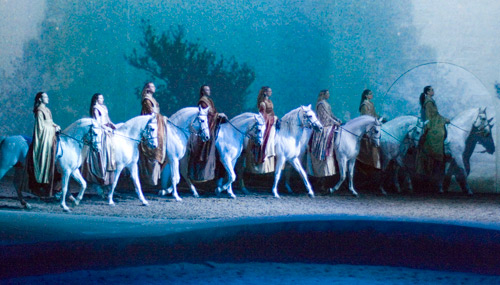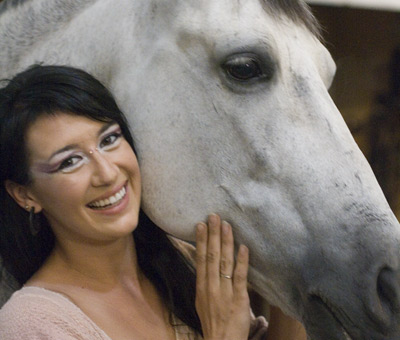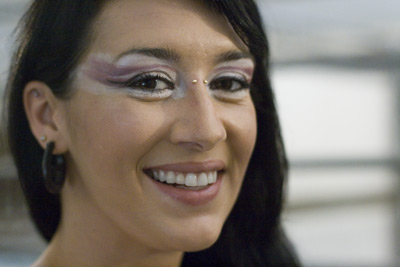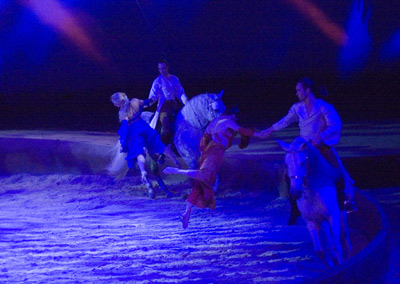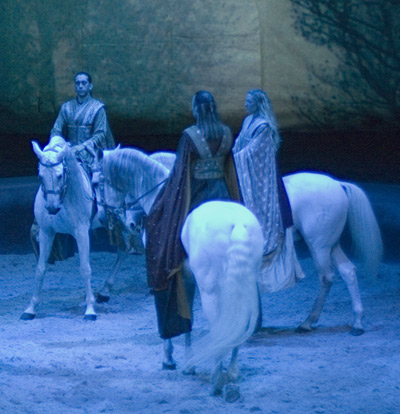Cavalia Comes To Town
By Kate Gardiner in Arts & Entertainment on Jul 28, 2009 9:00PM
The equine population of Chicago has tripled this summer, thanks to the horses performing in Cavalia in the West Loop.“It’s all about natural horsemanship and movement,” said performer Casey Hackett, 26. “We’re harnessing their energy into the performance, and the show changes every time.”
“It’s hard to know how the horses are going to react,” she said. “You have to really try to understand the dynamics between yourself and the horses and the audience. It was hard for me to realize how big the little things really are to them.”
Hackett, who trained first as a gymnast and has a degree in dance, said she never worked with horses before auditioning for the Canadian show. “They were looking, I think, for someone who had dance training who would be willing to work on the bungees,” she said. “I said yes, and then I ended up with four months in California, training.”
“My background is break and modern dance,” she said. “The sand floor [of the arena] forces you to be grounded, and makes it harder to pirouette. You really have to dig in.” But, she said, the surface gives her more possibilities.
“You can really throw your floor [routine] around, while you’re speaking to the horse with your body language,” Hackett said. “With the horses, it’s a very different experience, and you have to practice until it’s second nature. The relationship is empathetic.” Hackett’s horse-oriented performance is mostly a floor routine, driven by her partner, a 9-year-old white stallion who is free to move around the stage the whole show. “You have to be quiet, calm, confident,” she said. “It’s a state that allows you to work together.”
She spends the rest of her time on stage dangling from rope bungees on the ceiling, spinning, twisting and turning in time to the live music.
The show arose after one of the partners in Cirque de Soleil brought a horse into a performance. “Normand [Latourelle] noticed that the audience stayed with the horse,” said Bradley Grill, press attaché for the show. “No matter where they looked and what was going on in the show, the audience watched the horse.”
And that is the case during Cavalia’s three hours. The acrobats seem almost superfluous as they whirl and cavort on the stage. The horses, on the other hand, are integral to the lavish production. And they know it.
“There’s one horse,” said Hackett, “He was supposed to go on vacation, and so they sent him to a ranch in California. He was mopey and he started losing weight. They tried everything. Finally, they gave up and sent him back to the show. He improved immediately, went back to performing once per week. I guess he just needed to feel like he had a purpose.”
Hackett said she has gotten the horse bug during the more than 2 years she’s spent on stage with the act, though she’d never worked with horses before. “I’ve found the passion,” she said. “I’m trying to understand the horse, his willingness to perform.”
On stage, Hackett said she changes the show daily, depending on how her routine is going, and her horse’s mood. “You have to balance the partnership, learn to share the space and adapt… because we’ve been doing this routine so long I have the freedom to improvise.” Everything, she said, is flexible in the performance.
“My horse is staging the ‘primary encounter,’” she said. “He’s setting the scene for the rest of the show.” Before he sets the scene, however, he’s backstage, being prepped for his performance. Each horse is given a bath, trimmed and polished to perfection before being cued to the show, waiting for his turn in the limelight.
“The consistency is important to them,” Hackett said. “The people behind the show, that team, is focused on creating a stable environment back stage, coordinating appropriately and letting the horses do their duty.” She said since the team has to be so sensitive to the environment, they’re much closer together than on other shows. “Since we’re acrobats and dancers and we’re always surrounded by the horses,” she said. “We’re all very sensitive to the environment around us.”
Hackett said that while she has no intention of leaving the show in the near future, she is keeping up her training in more traditional dance. “I’m taking classes next door [at Hubbard Street] while I’m here, in modern, ballet, and break dance,” she said. Taking classes in the city she’s working in, “helps to bring us out and connect with the world,” she said.
“Chicago’s been very open, dynamic,” Hackett said. “The people make the city -and there’s a lovely, open vibe and feeling here.”
**
Tickets for the show are available online here. There are no particularly bad seats in the house, though closer to front-and-center is better.
More photos archived here.
